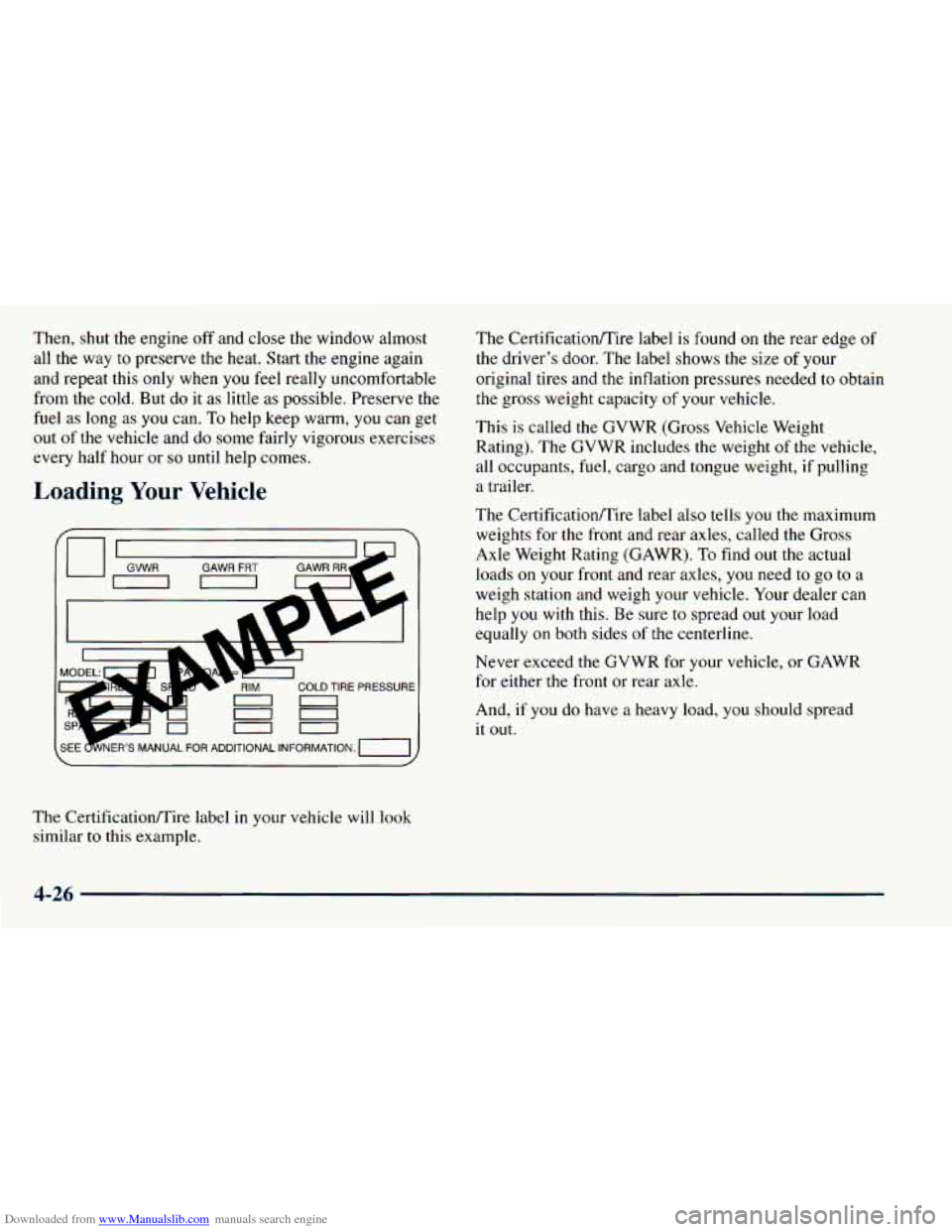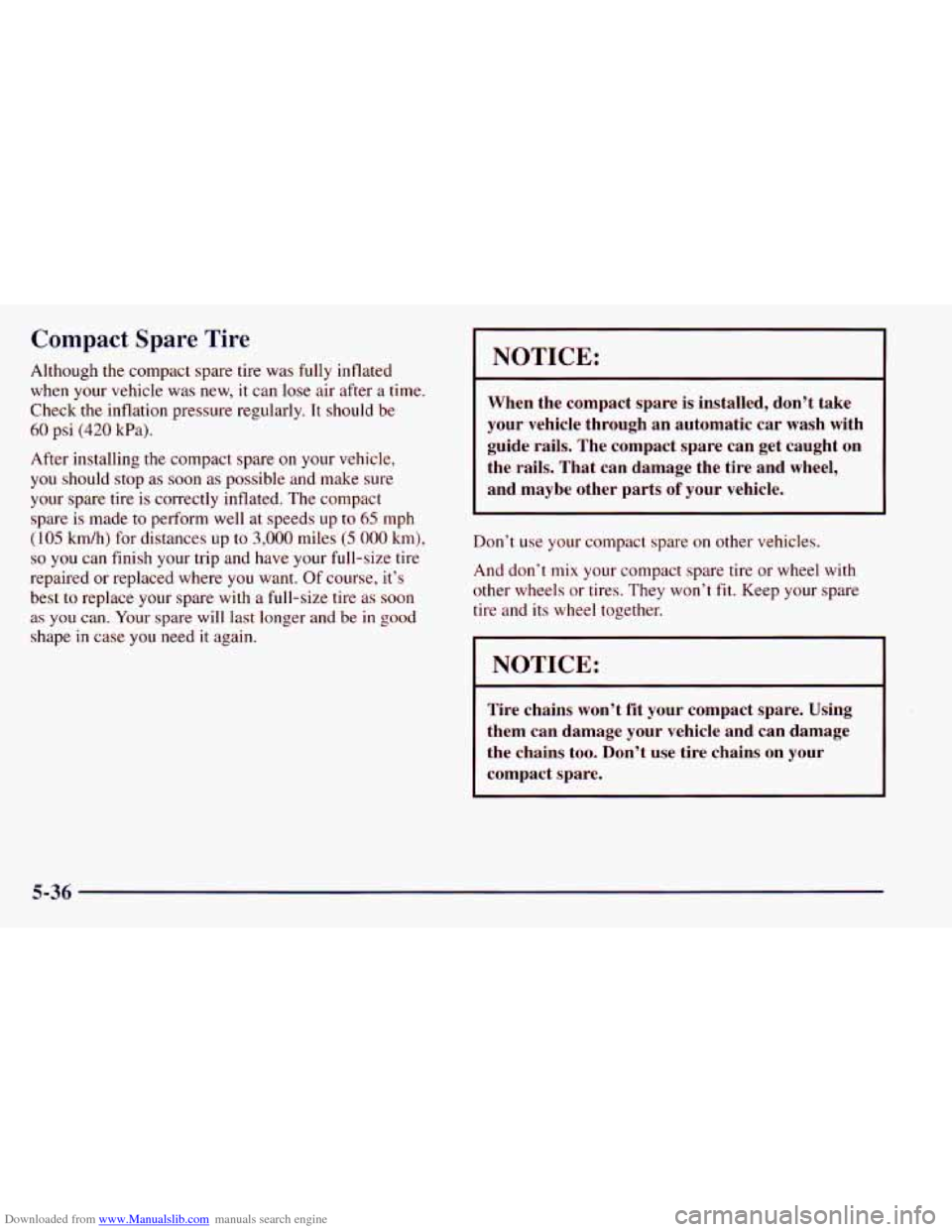1998 CHEVROLET ASTRO inflation pressure
[x] Cancel search: inflation pressurePage 210 of 414

Downloaded from www.Manualslib.com manuals search engine Then, shut the engine off and close the window almost
all the way to preserve the heat. Start the engine again
and repeat this only when you feel really uncomfortable
from the cold.
But do it as little as possible. Preserve the
fuel as long as you can. To help keep warm, you can get
out of the vehicle and
do some fairly vigorous exercises
every half hour or
so until help comes.
Loading Your Vehicle
no
GAWR FRT
(SEE dc
RIM COLD TIRE PRESSURE
--
VNERIS MANUAL FOR ADDITIONAL INFORMATION. -I
The CertificatiodTire label in your vehicle will look
similar
to this example. The
Certification/Tire label is found on the rear edge
of
the driver’s door. The label shows the size of your
original tires and the inflation pressures needed to obtain
the gross weight capacity of your vehicle.
This is called the GVWR (Gross Vehicle Weight
Rating). The GVWR includes the weight of the vehicle,
all occupants, fuel, cargo and tongue weight, if pulling
a trailer.
The Certificationnire label also tells you the maximum
weights for the front and rear axles, called the Gross
Axle Weight Rating (GAWR). To find out the actual
loads on your front and rear axles,
you need to go to a
weigh station and weigh your vehicle. Your dealer can
help
you with this. Be sure to spread out your load
equally
on both sides of the centerline.
Never exceed the GVWR for your vehicle, or GAWR
for either the front or rear axle.
And,
if you do have a heavy load, you should spread
it out.
4-26
Page 258 of 414

Downloaded from www.Manualslib.com manuals search engine Compact Spare Tire
Although the compact spare tire was fully inflated
when your vehicle was new, it can lose air after a time.
Check the inflation pressure regularly. It should be
60 psi (420 kPa).
After installing the compact spare on your vehicle,
you should stop as soon as possible and make sure
your spare tire
is correctly inflated. The compact
spare is made to perform well at speeds up
to 65 mph
(105 km/h) for distances up to 3,000 miles (5 000 km),
so you can finish your trip and have your full-size tire
repaired or replaced where you want. Of course, it’s
best to replace your spare with a full-size tire as soon
as
you can. Your spare will last longer and be in good
shape in case
you need it again.
NOTICE:
When the compact spare is installed, don’t take
your vehicle through an automatic car wash with
guide rails. The compact spare can get caught on
the rails. That can damage the tire and wheel,
and maybe other parts
of your vehicle.
Don’t use your compact spare on other vehicles.
And don’t mix your compact spare tire or wheel with
other wheels or tires. They won’t fit. Keep your spare
tire and its wheel together.
I NOTICE:
Tire chains won’t fit your compact spare. Using
them can damage your vehicle and can damage
the chains too. Don’t use tire chains on
your
compact spare.
5-36
Page 305 of 414

Downloaded from www.Manualslib.com manuals search engine A CAUTION:
Poorly maintained and improperly used tires
are dangerous.
Overloading your tires can cause
overheating as a result of too much friction.
You could have an air-out and a serious
accident. See “Loading Your Vehicle” in
the Index.
0 Underinflated tires pose the same danger as
overloaded tires. The resulting accident
could cause serious injury. Check all tires
frequently to maintain the recommended pressure. Tire pressure should be checked
when your tires are cold.
Overinflated tires are more likely to be cut,
punctured or broken by a sudden
impact
-- such as when you hit a pothole.
Keep tires
at the recommended pressure.
Worn, old tires can cause accidents. If your
tread
is badly worn, or if your tires have
been damaged, replace them.
Inflation -- Tire Pressure
The CertificatiodTire label, which is on the rear edge of
the driver’s door, shows the correct inflation pressures
for your tires when they’re cold. “Cold” means your
vehicle has been sitting for at least three hours or driven
no more than
1 mile (1.6 km).
NOTICE:
I
Don’t let anyone tell you that underinflation or
overinflation is all right. It’s not.
If your tires
don’t have enough air (underinflation), you can
get the following:
0 Too much flexing
0 Too much heat
0 Tire overloading
0 Bad wear
Bad handling
Bad fuel economy.
I
NOTICE: (Continued)
6-43
Page 306 of 414

Downloaded from www.Manualslib.com manuals search engine NOTICE: (Continued)
If your tires have too
much air (overinflation),
you can get the following:
0 Unusual wear
Bad handling
Rough ride
Needless damage from road hazards.
When to Check
Check your tires once a month or more.
Don’t forget your compact spare tire. It should be at
60 psi (420 kPa).
How to Check
Use a good quality pocket-type gage to check tire
pressure. You can’t tell
if your tires are properly inflated
simply by looking at them. Radial tires may look
properly inflated even when they’re underinflated.
Be sure to put the valve caps back on the valve stems.
They help prevent leaks by keeping
out dirt
and moisture.
Tire Inspection and Rotation
Tires should be rotated every 6,000 to 8,000 miles
( 10 000 to 13 000 km). Any time you notice unusual
wear, rotate your tires as soon as possible and check
wheel alignment. Also check for damaged tires or
wheels.
See “When It’s Time for New Tires” and
“Wheel Replacement’’ later in this section for
more information.
The purpose
of regular rotation is to achieve more
uniform wear for all tires on the vehicle. The first
rotation is
the most important. See “Scheduled
Maintenance Services” in
the Index for scheduled
rotation intervals.
3
When rotating your tires, always use the correct rotation
pattern shown here.
6-44
Page 307 of 414

Downloaded from www.Manualslib.com manuals search engine I
Don’t include the compact spare tire in your
tire rotation.
After the tires have been rotated, adjust the front and
rear inflation pressures as shown on the
Certificationire label. Make certain that all wheel nuts
are properly tightened. See “Wheel Nut Torque” in
the Index.
Rust or dirt on a wheel, or on the parts to which
it
is fastened, can make wheel nuts become loose
after
a time. The wheel could come off and cause
an accident. When you change
a wheel, remove
any rust or dirt from places where the wheel
attaches to the vehicle.
In an emergency, you can
use
a cloth or a paper towel to do this; but be
sure to use
a scraper or wire brush later, if you
need to, to get all the rust or dirt
off. (See
“Changing
a Flat Tire” in the Index.) When
It’s Time for New Tires
One way to tell when it’s
time for new tires is to
check the treadwear
indicators, which will
appear when your tires have
only
1/16 inch (1.6 mm) or
less of tread remaining.
You need a new tire if any of the following statements
are true:
0 You can see the indicators at three or more places
around the tire.
0 YOU can see cord or fabric showing through the
tire’s rubber.
The tread or sidewall is cracked, cut or snagged deep
enough to show cord or fabric.
0 The tire has a bump, bulge or split.
0 The tire has a puncture, cut or other damage that
can’t be repaired well because of the size or location
of the damage.
6-45
Page 375 of 414

Downloaded from www.Manualslib.com manuals search engine Part B: Owner Checks and Services
Listed below are owner checks and services which
should be performed at the intervals specified to help
ensure the safety, dependability and emission control
performance
of your vehicle.
Be sure any necessary repairs are completed at once.
Whenever any fluids or lubricants are added to your
vehicle, make sure they are
the proper ones, as shown
in Part
D.
At - Fuel Fill
It is important for you or a service station attendant to
perform these underhood checks at each fuel fill.
Engine Oil Level Check
Check the engine oil level and add the proper oil if
necessary. See “Engine Oil” in the Index for
further details.
Engine Coolant Level Check
Check the engine coolant level and add DEX-COOL’
coolant mixture if necessary. See “Engine Coolant” in
the Index for further details.
Windshield Washer Fluid Level Check
Check the windshield washer fluid level in the
windshield washer tank and add the proper fluid if
necessary. See “Windshield Washer Fluid” in the Index
for further details.
At Least Once a Month
Tire Inflation Check
Make sure tires are inflated to the correct pressures. See
“Tires” in the Index for further details.
Cassette Deck Service
Clean cassette deck. Cleaning should be done every
50 hours of tape play. See “Audio Systems” in the
Index for further details.
7-41
Page 407 of 414

Downloaded from www.Manualslib.com manuals search engine Starting Your Engine ............................ 2-17
Steam
........................................ 5-13
Steering ....................................... 4-8
In Emergencies
................................ 4-9
Power
....................................... 4-8
Tips
......................................... 4-9
Wheel, Tilt
.................................. 2-30
Storage Compartments
........................... 2-41
Storage, Vehicle
................................ 6-36
Stuck: In Sand, Mud, Ice or Snow
.................. 5-37
Sunvisors
.................................... 2-49
Sunglasses Storage
.............................. 2-47
Symbols, Vehicle
.................................. v
Taillamp Bulb Replacement ...................... 6-41
TapePlayerCare
............................... 3-29
Temperature
& Compass Display .................. 2-45
Theft
......................................... 2-14
Theft-Deterrent Feature
.......................... 3-26
THEFTLOCK"
................................ 3-26
Thermostat
.................................... 6-29
Third Gear
...... : ............................. 2-21
Tilt Steering Wheel
............................. 2-30
Time, Setting ................................... 3-9
Tirechains
.................................... 6-50
TireLoading
................................... 4-26
Tire-Loading Information Label
................... 4-26
Tires
.......................................... 6-42
Alignment and Balance
........................ 6-48
BuyingNew
................................. 6-46
Chains
..................................... 6-50
ChangingaFlat
.............................. 5-23 Cleaning
................................ 6-56
Compact Spare
............................... 5-36
Inflation
.................................... 6-43
Inflation Check
............................... 7-41
Inspection and Rotation
........................ 6-44
Loading
.................................... 4-26
Pressure
.................................... 6-43
Temperature
................................. 6-48
Traction
.................................... 6-47
Treadwear
................................... 6-47
Uniform Quality Grading
....................... 6-47
Wear Indicators
.............................. 6-45
Wheel Replacement
........................... 6-48
When It's Time for New
....................... 6-45
Top Strap
..................................... 1-58
Torque, Wheel Nut
......................... 5-33, 6-67
Towing a Trailer
................................ 4-28
Towing from the Front
....................... 5-9, 5-10
Towing from the Rear
...................... 5-1 1, 5-12
Towing Your Vehicle
............................. 5-7
Trailer Brakes
..................................... 4-32
Driving on Grades
............................ 4-35
Driving with
................................. 4-33
Hitches
..................................... 4-32
Maintenance When Towing
..................... 4-36
Parking on Hills
.............................. 4-36
Safety Chains
................................ 4-32
Tongueweight
............................... 4-31
Total Weight on Tires
.......................... 4-31
Towing ..................................... 4-28
Turnsignals
................................. 4-35
TorqueLock
................................... 2-25
9-9